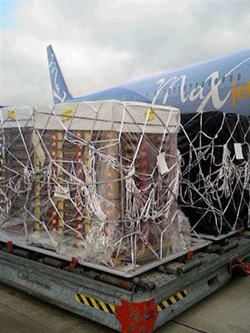leisure cargo Advances 2006
Alliances, the operative go-to tool these
days for expanding and in many cases improving coverage of markets have
found comfortable acceptance in both the passenger and cargo logistics side
of the airline business.
leisure cargo
of Düsseldorf, Germany created in 2000 is one alliance going strong
for the past six years.
If the words “leisure
cargo” sound like a contradiction in terms you are probably right.
German LTU Airlines started up a cargo business
to serve carriers that flew to holiday destinations and were paying little
or no attention to their holds as substantial revenue potential but instead
viewing them as wide open spaces for surf boards, ski equipment or excess
baggage.
“So the title leisure was
connected to cargo for an entire new group of airlines,” said Ralf-Rainer
Auslaender, Managing Director.
Today leisure
manages the entire cargo business of 18 airlines under the steady hand of
Mr. Auslaender who admits that the road to success was not guaranteed.

Ralf-Rainer Auslaender (left) and Christian Weidener (right)
“The idea of taking over the
entire resource of a carrier’s uplift was a tough sell in the beginning,
but now in a revenue-strapped environment, success has built upon success.”
In terms of bottom line target 2006 revenues
expected are for EUR 56 million and the carriage of 44,000 tons of freight
to and from some 200 destinations via more than 240 aircraft.
But good things at this company do not happen
by accident or luck.
Christian Weidener, leisure’s director
global operations has to be an understated behind the scenes manager with
an eye and ear for detail so he can make the moves to secure the best
handling partner at various destinations, each with its own special peculiarities.
“To guarantee leisure cargo service
standards, cargo ground handlers must closely coordinate their warehouse
and ramp activities with the passenger-handling agents contracted by the
respective airlines,” Weidner says.
An example of how this collaborative approach
can work well is the busy Air-Berlin hub in Palma de Mallorca.
Flocks of AB aircraft arrive one after the
other in three major waves every day. At times the planes are lined up
at the terminal with their distinctive lettered tails tracing off into
the horizon. With ground time at an absolute minimum the coordination
of travellers and cargo both moving from separate sources must work like
clockwork.
Several European carriers have joined the
leisure family this year—Air-Berlin, Hapag-Fly, dba, SkyEurope,
Thomas Cook Belgium and ARKEfly.
Innovative additions are worked into the
agreement packages. As example, a cooperation based on a special prorate
arrangement with Venezuelan Santa Barbara Airlines on certain routes.


Photo left—One of the youngest members in the club is U.S.-based
executive carrier MAXjet brought in by U.K. based leisure GSA Global
Aviation Logistics Limited.
Photo right—leisure
cargo Director Global Operations Christian Weidener and his assistant
Mrs. Agnes Allnoch are constantly “on the road” both pictured
here, in Madrid with Jordi Pique, (seated) Director of CRS Airlines
Representatives. |
MAXjet, the USA flag based in Washington
D.C. is becoming a full-fledged partner.
“When executives experience our virtual
airline concept and the regular on-time payments the more obvious the
deal becomes.
“We are the cargo airline with all
the bells and whistles including an integrated service system that automatically
opens up traffic from many sources.
“leisure also has the most advanced
track, trace and customer care available anywhere, but we are also aware
of our responsibility to integrate our cargo business with the requirements
of the carriers we serve.
“That means on time everything and
no surprises.”
The colourful leisure schedule, which includes
all 18 carriers, is very detailed listing 200 destinations from A-Aberdeen
to Z- Zurich with exotic places like Friedrichshafen, Iquique, Kavalla
or Samana in between.
Now that North and South American destination
carriers have joined the fold, the direction of future activities might
be “east” as there are many ideal candidates emerging in markets
of Eastern Europe and Asia for the business model described here.
GFM
|




